Victor's Use of Matrix Numbers
By Howard S. Friedman
Table of Contents
See Also:
- Matrix and Catalog Numbers in G&S Discography
- Gramophone Company Matrix and Catalog Numbers
- Matrix Numbers in Recordings of Gilbert & Sullivan
- Summary of Recording Histories
Victor's Use of Matrix Numbers
The Victor Company and its successors made no Gilbert and Sullivan recordings of any note, except the three sets on so-called long playing discs of the Victor Light Opera Company's H.M.S. Pinafore, the Civic Light Opera Company's Mikado, and the 1932 Pirates of Penzance. None of these have discernible matrix numbers. The Victor releases of the Gilbert and Sullivan operas were imported and repressed from the original Gramophone Company matrices. However, the worldwide importance of the recordings and related activities of the Victor Company impels the writer to present a detailed study of the matrix number systems used by them.
Eldridge Reeves Johnson founded the Consolidate Talking Machine Company in August 1900. When he became embroiled in litigations over various patent rights, he approached Emile Berliner, and founded the Victor Talking Machine Company on October 3, 1901. Berliner received forty percent of the stock, for which he gave Johnson the rights to the gramophone patents, which apparently included those for both the manufacture of gramophones and the recording process. This seems evident from the three patent numbers on the identification plate for the 1895 Berliner Gramophone, shown in Part One of this article. Patent No. 372,786 of November 8, 1887, deals with both the gramophone itself and a recording process on cylinders; No. 534,543 of February 19, 1895, deals with the gramophone machine itself, while No. 382,790 of May 15, 1888, is concerned with the zinc plate recording process.
The Evolution of the Victor Label
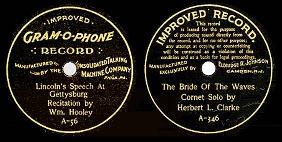 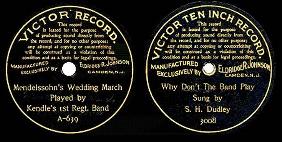 Left: The first Eldridge Johnson label, introduced on seven-inch discs in the spring of 1900. A-56 was recorded on June 7, 1900, and remade on November 6. Center Left: Johnson was ordered not to use the word Gram-o-phone on March 1, 1901. The result was the Improved Record label, which dropped the Consolidated Talking Machine Company name. This label also reflected Johnson's move from Philadelphia to Camden, although some reverse-side stickers from this period list both cities (the studio remained in Philadelphia for some time after the move). A-346 was recorded on October 5, 1900, and remade on June 5, 1901. Center Right: Johnson first registered the Victor trademark on March 12, 1901, under his own name (the Victor Talking Machine Company had yet to be formed). This seven-inch version of A-639 was originally recorded on January 26, 1901, but was remade several times as the stampers wore out. Right: The extremely rare Victor Ten Inch label marked the introduction of larger-diameter Victor discs. This label was in production for only a short time, probably in early-to-mid 1901, before being replaced by the Monarch label. #3008 was recorded on January 5, 1901. |
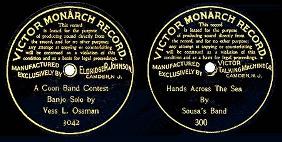 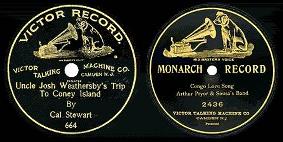 Left: The Victor Monarch label was adopted for ten-inch discs later in 1901. The earliest version still listed Johnson as manufacturer. #3042 was recorded on January 21, 1901. Center Left: The Victor Talking Machine Company was founded on October 3, 1901, and its name soon appeared in place of Johnson's on Victor labels. This ten-inch version of #300 (which retained the catalog number of the corresponding seven-inch version) was originally recorded on January 3, 1902. Center Right: The first label design to incorporate "His Master's Voice" was registered on July 1, 1902. This seven-inch example was initially recorded in February 1901 but was remade several times over the following years. The small "B" to the right of the trademark indicates a contract pressing by the Burt Company, which at the time was owned by Columbia. Right: The straight-line label was introduced in 1903, and the basic design would survive with some modifications for the next decade. This example was issued in late 1903. |
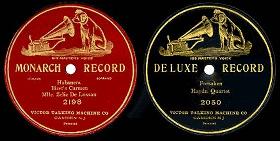 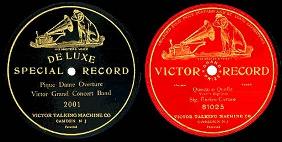 Left: The first domestically recorded Red Seals were introduced in 1903 on the Monarch (ten-inch) and Deluxe (12-inch labels). Center Left: The Deluxe label was reserved for twelve-inch discs. Company files for the elusive 2000-3000 series have been lost, but this example probably dates to 1903. Center Right: Among the rarest Victor labels, the Deluxe Special was a short-lived series of 60-rpm, fourteen-inch discs introduced in March 1903. Company files no longer exist for these monstrous long-playing discs, few of which survive today. Right: In March 1905, Victor discontinued the Monarch and Deluxe designations in favor of a uniform Victor label on all diameters. This early example of the "Grand Prize" label uses a master recorded by Enrico Caruso on February 1, 1904, which was originally issued under the Monarch label. |
(The photos above are adapted from and reproduced with the permission of Kurt Nauck of Nauck Vintage Records. The descriptions are courtesy of Allen Sutton of Mainspring Press. My thanks and appreciation to both.)
The Pre-Matrix Period
Victor, or rather Consolidated, was making recordings as early as May 17, 1900. (Fagan and Moran indicate at least 17 earlier recording sessions, beginning on January 12, 1900.) Since they had not yet received the rights to Berliner's recording process, these recordings were largely surreptitious. At this time there were actually no matrix numbers. Instead, they used a "serial number", which was also the catalog or disc number. The term "matrix" was used at that time to designate the numbers assigned sequentially to any "takes" of a given serial number. Catalog numbers were assigned in blocks according to the size, and hence the price of the record.
The price of a record was determined by the amount of playing time for each size. In March 1903, a 7-inch record provided not more than 2 minutes of recorded sound, and cost 50 cents. A 10-inch disc that could play for about 3 minutes cost one dollar, while a 12-inch disc providing about 4 minutes of playing time was priced at $1.50. At this time Victor announced the sale of the new 14-inch De Luxe Special discs, which played for 5-6 minutes, at $2.00 each. These were all single-sided discs. When G&T, and then Victor, introduced double-sided records after 1912, the prices were increased accordingly.
The first number in the pre-matrix series, A-1, was assigned to a recording made by George Broderick on June 28, 1900, and consisting of a recital of a poem called "Departure," by Eugene Field. All Victor recordings up to April 30, 1903 received the A prefix, regardless of the size of the record. This continued up through A-2324, recorded about May 17, 1903. The second side A-2 was recorded on May 17, 1900, and up to A-109 many serial numbers were assigned out of the order in which the sides were recorded. This was correct beginning with A-110, recorded on July 11, 1900. The serial number also appeared as the record, or catalog number.
The first recorded take was not usually indicated on the record itself. Nearly all of the 2301 or more sides on 7-inch matrices were re-recorded on either 7-inch Victor discs with V prefixes and the same serial number, or with M prefixes, indicating a 10-inch or Monarch disc. The retakes were usually made much later than the original side, and in completely random order. The first 10-inch recordings were made on January 3, 1901, and were assigned a block of numbers beginning with M-3000 through M-3623. Twelve-inch, or De Luxe records were given serial numbers starting with 31000. Fourteen-inch, or De Luxe Special records started with number 41000. All of the latter were remakes, i.e., re-recordings of earlier 12-inch takes.
A serial numbers were apparently assigned in blocks, A-1 through A-999 being allocated to domestic seven-inch records. The block starting with A-1000 was reserved for a group of European imports, including some of Fred Gaisberg's June 1900 Milan recordings. After A-1009 the numbers reverted to the domestic series through A-2000. The disc number A-1168 seems to have had the imprint R-1, indicating possibly the appearance of a 12-inch record, perhaps under a Royal label. This serial number initiated a series of some sixty recordings, made almost entirely by John Philip Sousa's band. Nearly all of these have R- imprints. For further details of this extremely convoluted system and its manifest results, the reader is referred to Fagan and Moran's first volume on the Victor pre-matrix series.
This series is known as the Pre-Matrix series, i.e., before Victor had obtained legal rights to the Berliner recording process. The last recording session known to have used the A prefix numbering system was on May 1, 1903. The entire series is particularly noteworthy for its total lack of celebrities, with a few exceptions, including the great tenor Emilio de Gogorza, and the Sousa band. One complication which Victor introduced was the duplication of essentially all of its 7-inch recordings on 10-inch discs (see above). The reason for this is unknown, but the same serial number was usually used for both discs, the difference being the prefix letter. Take numbers consisted of a number suffix separated from the serial number by a dash.
 Left and Left Center: Two Victrola labels, showing variations of the patent statements. Victrola 89040 and Victrola 95210, respectively. There were other variations. Right Center and Right: Victor 88060. The box on the right is embedded on the reverse to identify an American Victrola Red Seal record. |
Victor Matrix Numbers
The pre-matrix system ended on April 30, 1903, when, in Carnegie Hall facing Seventh Avenue in New York City, in a rented Studio 826, which had been converted into a recording studio, the first Victor Red Seal recording was made. From that time on they assigned their own matrix numbers. From its inception, Victor's matrix number system was quite different from that of the Gramophone and Typewriter Company, consisting of a letter prefix, a serial number, and a suffix number indicating the "take". Fagan and Moran point out that the three components together make up the matrix number. The prefixes A, B, C, D, and E, were assigned to 7-, 10- 12-, 14-, and 8-inch discs, respectively. The first four sizes continued to be designated Victor, Monarch, Deluxe, and Deluxe Special, as they had been for the pre-matrix series. The 7- and 14-inch discs were abandoned almost immediately while the 8-inch disc was discontinued about 1908. The same selection, recorded by the same artist, would have the same matrix number with the appropriate prefix letter on each of the different sizes.
Since the first recording in Carnegie Hall had the matrix number A-1, there was some initial confusion. This was solved when this A-1 became 2182, and B-2, recorded on the same day, became 2181. This was simply a continuation of the pre-matrix numbering system, which had ended with A-2180 on April 23, 1903. The serial numbers continued from 1 through 104,075 in August 1936, at which point the matrix numbers started over again with 01.
According to Perkins, Kelly, and Ward, this system was introduced by Victor when it took over some of the artists who had recorded formerly with G&T. Thus, all of Caruso's recordings following the 1902 Milan groups were made in Victor's New York studios up through March 10, 1908. Thereafter they were made either in New York or in Victor's studios in Camden, New Jersey. Victor signed its first contract with Caruso on January 28, 1904. Three days later, he made his first American recordings. Eight of the ten recorded sides had B matrices, while his first two 12-inch sides were assigned C matrices. This B/C prefix system was used, with some modifications, throughout the rest of the acoustical and the early part of the electrical recording period, as all but 10- and 12-inch disc sizes were soon dropped.
The Victor company kept track of the number of stampers, i.e., negative copies of the master matrix, by placing one or more letters in front of the catalog number, which was generally imprinted on the disc at 12 o'clock. So-called "first editions" were imprinted A, while subsequent stampers had other letters. A stamper was used for a fixed number of pressings before it was discarded. An early pressing from a stamper with a higher letter was generally preferable, in terms of loudness and fidelity, to a late pressing from an earlier stamper.
From the time it was formed in 1901, the Victor Talking Machine Company and its several successors imported numerous matrices from the Gramophone & Typewriter Company, to be pressed and sold in this country and elsewhere. Julian Moses lists nearly 700 sides in Victor's Red Seal Celebrity series alone. Victor generally retained the original matrix number on imported G&T matrices. During the electrical recording era, Victor stamped over or near the G&T matrix number with V.E. in an oval or diamond. These are not the same as BE or CVE matrix numbers (see above).
At the same time, the Gramophone Company was importing Victor recordings to be repressed and issued in the European area. All of the Victor matrices issued by G&T retain the original Victor matrix number, and all have the A prefix, apparently for "American", regardless of the record size. Bennett lists many Victor recordings of the 1904-1905 period on the G&T label, having matrix numbers with A prefixes, Conversely, the writer has several early Victor pressings from G&T matrices, on which the prefix A has obviously been added to the original matrix number, presumably by G&T before they were imported by Victor. It is worth noting that G&T discs reissued under the Victor label usually had the notation "Recorded in Europe" printed under the name of the selection and/or artist.
After mid-1906, Victor no longer stamped their matrix number onto the disc in the area around the label, but apparently maintained it in the central area beneath the label. When these matrices were sent to G&T to be pressed and issued in England, the matrix number was visible, and could be both printed on the label and reentered onto the disc area outside the label. G&T continued the practice of adding A to the original Victor matrix number stamped on the disc, to distinguish them from the original Victor matrix number, which had a C prefix for 12-inch discs (see above).
The writer has an original Victor 81062, a Caruso recording made in Victor's New York studio on February 17, 1905, on which the matrix number B2344 has been handwritten. He also has a Plançon recording of 1906, Victor 85099, with the handwritten matrix number B3029. Fagan and Moran confirm the existence of both engraved and handwritten matrix numbers at the 6 o'clock position through the middle of March 1906.
A further anomaly exists with Caruso's January 21, 1914 recording of "Manella mia", on HMV 2-052091. The recorded area is so close to the label, that there was no room for G&T to enter the matrix number.
According to John Bolig in his discography of Caruso's recordings, A plates or stampers were the first editions. He says further that these designations appeared on the record next to the catalog number. He says also that early Victor records included the matrix number, but on later issues (after 1906) the matrix number on Victor pressings was replaced by the "take" number, usually a small Arabic numeral stamped on the disc to the left of the label, although sometimes it was an alphanumeric pair. One must distinguish here between the alphanumeric designation of the matrix edition, that is, whether it was the master matrix or a copy or stamper made thereafter, and any prefixes assigned to basic matrix numbers. The interested reader is referred to Fagan and Moran's excellent discussions of the markings on Victor matrices.
Another practice in this regard, apparently of the Gramophone & Typewriter Company, was to stamp both the Victor record number and its own record number on the matrix above the label, in addition to the matrix number itself. This has been seen on G&T discs from 1905 to as late as 1926, and can provide a wealth of information, if one knows exactly what one is looking at. Interestingly enough, all of the 4 discs seen, including the 1926 disc, were single-sided.
Within this concept one finds the occasional anomaly. The writer has HMV disc number 2-052061, Caruso's 1911 recording of "Io non che una povera stanzetta" from Leoncavallo's La Bohème, with the matrix number CA11276. The Victor number was of course C11276, and one would expect that a release by the Gramophone Company would have the matrix number prefixed with A. Even more interestingly, Bennett lists this matrix number with the A prefix alone.
Bennett lists matrix numbers as low as A188, issued in 1903, in his Italian Catalogue. This recording was attributed to "Francisco," one of several noms du disque used by Emilio de Gogorza, This is a Victor recording, repressed by G&T engineers. Moreover, Bennett lists all Caruso recordings on G&T labels with an A prefix, although the matrix numbers themselves are clearly those assigned by the Victor company. Of some interest is the fact that Bennett's Italian Catalogue seems to have been just that, a list of G&T recordings in the Italian language, but not necessarily made in Italy.
Victor's Electrical Recording Period
In February 1924, Victor began releasing its "Music Arts Library of Victor Records," using a special group of European recordings with masters imported from its English affiliate, the Gramophone Company, Ltd. The D'Oyly Carte Opera Company (sic) recordings of The Mikado (1917) and Pinafore (1922) were among this group of releases. (See Read and Welch, p. 258, who either saw the statement "Recorded under the direction of the D'Oyly Carte Opera Company" on the disc labels, and below this in parentheses "Mr. Rupert D'Oyly Carte," or else quoted someone else who had misinterpreted these statements.) The release of The Mikado was announced in the Victor supplement of March 1, 1925, and Pinafore in the supplement of August 1. See also The Acoustical Mikado and Pinafore in America.
At the beginning of the electrical recording era, about April 1925, RCA began imprinting a V.E. in a circle near or over the matrix number of acoustical recordings, below the label of all such recordings. When electrical recordings replaced acoustical performances, it was common to use the same basic matrix number, and to replace Bb or Cc with BVE or CVE. The reader should note the difference between a matrix number with a V.E. overprint stamp, and one with a BE or CVE prefix. The former are electrically amplified or re-recorded from the original matrix, while the latter are new electric recordings.
Victor used these releases until the Western Electric recording process could be perfected, which was not until the following year. The first electric disc recording was probably made on or about February 1, 1925, when Victor allowed radio station WEAF in New York City to broadcast a recording by the violinist Renée Chemet. As with Berliner's original gramophone, the release of electric recordings was not practical until a phonograph capable of playing them faithfully could be provided to collectors. This occurred on what was known as Victor Day, which was November 2, 1925. On this date the electric Orthophonic Victrola was introduced to the public. At the demonstration of this instrument, John Philip Sousa, who had given Victor its first important testimonial in 1901, said, "Gentlemen, that's a band."
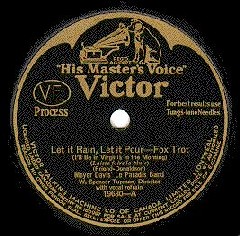 |
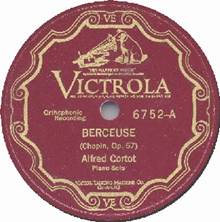 |
| Victor Orthophonic Labels | |
In October 1925, Victor reissued Chaliapin's European recordings of the Coronation Scene from Moussorgsky's Boris Godunov on Victor 11485. The matrix numbers Cc7064III and Cc7066I are clearly visible on the pressings. Similarly, the matrix numbers CR2142I and CR2143III can be seen on the July 4, 1928, recording of the "Prayer and Death of Boris," Victor 15177. So too the matrix numbers on Chaliapin's recordings of "Le Veau d'Or" and "Vous Qui Faites l'Endormie," from Faust, on Victor 7600, and the Clock Scene from Boris Godounov on Victor 14517. Essentially all of the Victor repressings of Caruso's imported G&T recordings retain the original matrix numbers.
Examination of the Victor releases of the first electric series of Gilbert & Sullivan recordings shows that the original HMV matrix numbers were retained. However, they are generally overstamped by V.E. in an oval or circle, making it difficult to read them. These are certainly exceptions to RCA's usual practice, which was to remove the G&T matrix number and replace it with its own record number. Therefore let the discographer beware of using RCA imported pressing for discographic data, for he/she will generally find little if any! What one may find is that the RCA record number has been stamped into the matrix used for the repressings.
In late 1928 the Victor Talking Machine Company merged with the Radio Corporation of America, and became the RCA Victor Division. From the beginning of its existence, this division had been inconsistent in its handling of matrix numbers, as can be seen from the comments above. In many instances the company rendered a disservice to both the discographer and the record collector when they repressed matrices imported from Europe.
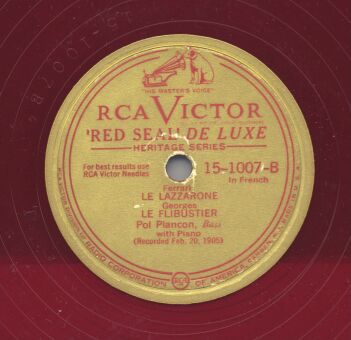 RCA Victor Red Seal De Luxe Record 15-1007-B, 1948 reissue of the 1905 recording of Pol Plançon's "La Lazzarone" and "Le Filibustier" |
I have, for example, the 1948 RCA Victor 'Red Seal' De Luxe Heritage Series issue number 15-1007, pressed on translucent red vinyl, of Pol Plançon's 1905 recordings of "O Isis" from The Magic Flute (side A) and "La Lazzarone" and "Filibustier" (misspelled "Flibustier" on the label) on side B (see picture above). On the unrecorded areas outside the labels on both sides, one can see readily that both matrix numbers have been shaved off or otherwise removed. They did not bother to smooth the area over on the B side, so it is quite evident, and the original matrix number A2323 is still almost legible.
Victor was very haphazard in their placement of the label on the record surface, contrary to G&T, who almost invariably aligned the label with the incised matrix number at 6 o'clock. On Victor pressings of G&T imports one finds at least 3 different numbers. The G&T matrix number is usually maintained. If one orients this number at 6 o'clock, then the Victor catalog or disc number will be at 12 o'clock. If the record is to be issued in a set, and if the set has either slide or drop automatic coupling, he catalog number assigned to that set will be imprinted below or near the manual coupling number.
I have examined four sets of Victor's issues of the 1936 Mikado, including one manual coupling, three drop couplings, and three extra discs. With the G&T matrix number at 6 o'clock, I have seen the number 1 or 2 imprinted at 9 o'clock, while another number or alphanumeric combination appears at 3 o'clock, but upside down. These numbers are not only often extremely faint, but they may occur on the lead off grooves. Which of these imprints may indicate the stamper edition, I cannot say at this time.
In examining the four sets mentioned above, every record (all 192 sides!) was examined. In all instances except one, the matrix number had a V.E. in a diamond stamped over or near the matrix number. Some of these imprints are so faint as to be almost undetected. In one instance this imprint could not be found by any means. Moreover, the take number at 9 o'clock was 2 instead of 1.
In summary, the Victor Talking Machine Company used two basic systems for numbering their recordings. The pre-matrix system was used from (actually) May 1900 through April 23, 1903, and assigned various prefixes and blocks of numbers for 7-, 10-, 12-, and 14-inch recordings. From April 23, 1903 until the end of the acoustical era, the matrix numbers were sequential, using B prefixes for all 10-inch records and C prefixes for all 12-inch records, the production of 7-, 8-, and 14-inch records having been stopped before 1908.
The use of B and C continued as late as 1930. When the electrical recording era began, Victor changed the B/C prefixes to BVE/CVE. As early as 1938 Victor was using a matrix number system involving the block 045000 to 076000, which lasted until at least 1942. Little is known of this series. From about this time forward, until the end of the 78rpm era, Victor, now RCA, used various systems with a variety of prefixes. The purpose of these different and concurrent systems is unknown to the writer at this time. However, they still did not stamp the matrix number on the disc in any fashion.
At some period following World War II, Victor devised an elaborate system of prefixes, involving a four-character alphanumeric format, e.g., D6-RB. This had advanced as far as E0-RC by 1956, by which time, recording on 78 rpm matrices had ceased. However, it seems to have been continued into the LP period, up to E4-RCin 1956, but did not extend into stereo recordings. One may note that the BSO/CSO prefix was assigned to a series of Victor recordings made by the soprano Lucrezia Bori in July and August of 1937.
Matrix Numbers on Other Record Labels
In his The Recordings of Enrico Caruso, A Discography, John Richard Bolig writes:
Early Gramophone and Typewriter labels were red with gold lettering (much like the RCA Victor Red Seal issues). In 1908 G & T issued pink labels, and in 1909 the dog trademark was added. After 1909, G & T became the Gramophone Company Limited, and His Master's Voice or an appropriate translation appeared on the labels of all companies affiliated with the Gramophone Company Limited. Label colors were coded to indicate the language being sung, the record size, and the number of featured artists.
Pathé labels were etched into the rim of the cylinders and onto the surface of the discs.
Zonophone records had blue labels with gold lettering.
[The following applies to RCA recordings only.]
The symbol S/8 to the left of the label on several records refers to transcribed stampers (i.e., matrices). Later, the symbol 10S was used to refer to the same thing. Electronically-amplified or re-recorded records bear the symbol VE. The re-recordings with dubbed symphony orchestra are among the worst transcriptions ever produced. Although these sold well, the serious collector is rarely interested in transcriptions, unless the recordings appear in no other form.
(Note: I have several of these, and can vouch for their miserable effect on the ears! The collector should avoid them at all costs! I had the misfortune to purchase three Caruso re-recordings as my nearly first excursion into this area of collecting. They are certainly ghastly!)
 Columbia Graphophone |
The oldest name still extant in the recording industry is Columbia. Founded in 1889 and named for the District of Columbia where it was originally located, it was here that Fred Gaisberg first recorded cylinders under license from the American Graphophone Company and others. Early Columbia records in the acoustical era bore no distinguishing matrix numbers. Instead, from about 1912 until as late as 1930, the record number was the same as the one stamped on the matrix. After the introduction of electrical recording, a system of unique matrix numbers similar to that used by G&T and HMV was used, with various one- or two-letter prefixes. These included the use of W, WA, WAX, WBX, and so forth, as well as CA and CAX, through 1950. The added letter X in these series apparently indicated a 12-inch matrix. In most instances the matrix number, with the prefix but without any suffixes to identify different takes, appeared on the label. Sometimes an additional letter was added to the printed prefix, or the additional letter was stamped into the matrix but was not printed on the label. Columbia electric recordings are known in which the bare number is stamped onto the matrix, while the label has a 3-letter prefix. Confusion! After 1925, Columbia finally identified different takes by a simple hyphenated Arabic numeral suffix.
Columbia apparently used different matrix number systems for their European and American recordings. The reader is referred to the Brooks and Rust book listed in the Bibliography.
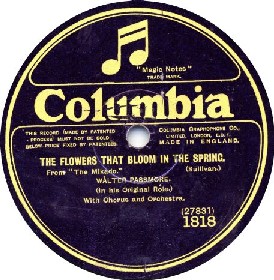 Columbia 1818, Walter Passmore's "The Flowers That Bloom In The Spring," 1912 |
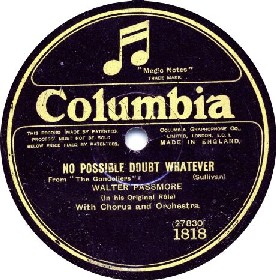 Columbia 1818, Walter Passmore's "No Possible Doubt Whatever," 1912 |
Our knowledge of the matrix number system for Odeon is necessarily limited. Odeon, which has the distinction of having produced the first double-sided discs in 1904, seems to have used a simple identifying matrix number consisting of the plate number preceded by the prefix Lx. This system was used until at least 1911, perhaps later, Odeon merged with the Italian Fonotipia firm some time before 1912. Both companies also used x or xx prefixes, to designate 10- and 12-inch matrices, respectively. Fonotipia used xPh, xxPh, and xxxPh for 10-3/4, 12, and 13-3/4 inch discs, respectively, from October 1904 through the 1920's, while Odeon used xB and xxB, respectively.
Matrix Numbers in Recordings of Gilbert & Sullivan.
Bibliography
Bennett, John Reginald. Voices of The Past. Vol.1. A Catalogue of Vocal Recordings from the English Catalogues, 1898-1925. Oakwood Press, 1956. (1978 Greenwood Press reprint.) ISBN 0-313-20237-0.
Bennett, John Reginald. Voices of The Past. Vol. 2. A Catalogue of Vocal Recordings from the Italian Catalogues, 1898-1925. Oakwood Press, 1957.
Bennett, John Reginald. Voices of The Past. Vol. 3. Vocal Recordings 1898-1925. Supplement to "Dischi Fonotipia." Oakwood Press, 1957.
Bolig, John Richard. The Recordings of Enrico Caruso, A Discography. Published by the Eldridge Reeves Johnson Memorial Delaware State Museum, Dover, Delaware, 1973.
Brooks, Tim, and Brian Rust. The Columbia Master Book Discography, Volumes I, II, III and IV. Westport, CT: Greenwood Press, 1999. ISBN: 0-313-29217-5 (entire set)
Chew, V. K. Talking Machines 1877-1914. Her Majesty's Stationery Office, London, 1967. SBN 11 290162 X.
Clough, Francis F., and G. J. Cuming. The World's Encyclopædia of Recorded Music, 1966. Sedgwick and Jackson, London. (Greenwood Press, Publishers, Westport, Connecticut 1975 reprint.) ISBN 0-8371-3003-4
Fagan, Ted, and William Moran. The Encyclopedic Discography of Victor Recordings: Pre-Matrix Series. Westport, CT: Greenwood Press, 1983. ISBN 0-313-23003-X.
Fagan, Ted, and William Moran. The Encyclopedic Discography of Victor Recordings: Matrix Series: 1 through 4999. Westport, CT: Greenwood Press, 1986. ISBN 0-313-25320-X.
Francis, John W. N. "The Gilbert and Sullivan Operettas on 78s." ARSC Journal, Volume 20, No. 1 (1988-1989).
Gelatt, Roland. The Fabulous Phonograph 1877-1977. MacMillan Publishing Co., Inc., New York, 1977. ISBN 0-02-542960-4.
Koenigsberg, Allen. The Patent History of the Phonograph, 1877-1912. Revised edition. Brooklyn, NY: privately printed by the author, 1991. ISBN 0-937612-13-8.
Moore, Jerrold Northrop. A Matter of Records: Fred Gaisberg and the Golden Era of the Gramophone. Taplinger Publishing Company, New York, 1977.
Moses, Julian Morton. Collector's Guide to American Recordings 1895-1925. Dover Publications, Copyright 1949 by the American Record Collectors' Exchange.
Perkins, John, F., Alan Kelly, and John Ward. "On Gramophone Company Matrix Numbers 1898 to 1921." Published in The Record Collector, Ipswich, Suffolk, England, Vol. XXIII, Nos. 3 & 4, May, 1976.
Read, Oliver, and Walter L. Welch. From Tin Foil To Stereo. Howard W. Sams & Co, Inc., Indianapolis, 1976. ISBN 0-672-21206-4
Smith, Michael, compiler. The Gramophone Company Ltd His Master's Voice Black Label 12 & 10-inch "D" & "E" 78 rpm Series. Witley Press, Hunstanton, England.
Sutton, Allan, and Kurt Nauck. American Record Labels and Companies, An Encyclopedia (1891-1943). Mainspring Press, Colorado, 2000.
Wolfson, John. The Savoyards on Record. Packard Publishing Limited, Chichester, England, 1985.
